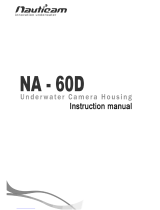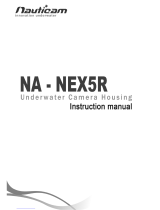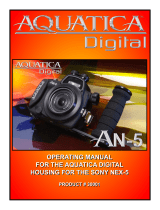Page is loading ...

Product Registration
Please register your product at ikelite.com within 15 days of purchase.
Our product registration database is the best way for us to get a hold
of you in the event of a product update or recall.
Underwater Housing for Sony Cyber-shot RX100
Mark III, Mark IV, Mark V
Product Number 6116.15

2
About this Product
Thank you for your purchase of Ikelite equipment. Please read this
instruction manual completely before attempting to operate or dive
with this product. Please visit ikelite.com to register your product to
receive information on any updates, notices, or recalls pertaining to
your equipment.
Included in the Box
• Housing # 6116.15
• Port cover # 0200
• Silicone lubricant 1cc tube
Specications
• 200 ft (60m) depth rating
• Controls for all camera functions except Flash switch and
Viewnder switch
• Slightly negative buoyancy in fresh water
• 1/4-20 thread tray mounting with 3 in (76mm) spacing
• Weight 2.6 lb (1180 g)
• Dimensions 6.8 x 5 x 5.4 in (173 x 127 x 137 mm)
• 3.0-inch diameter glass lens port

3
Important Notices
» Never leave a housing in a rinse tank, even if it is the only
system in the tank. The vast majority of catastrophic oods
happen when the user walks away from a housing while it is in
the rinse tank.
» To prevent salt build-up and sticking controls, submerge the
empty housing in clean, freshwater. Operate the controls
several times each while underwater to ush out any residue.
» Do not use alcohol, cleaning agents, spray lubricants, Rain-X,
or other solvents on the housing or lens port. Use of an
incompatible chemical compound can damage the plastic and
o-rings, and may result in leaking.

4
Contents
Product Registration 1
About this Product 2
Included in the Box 2
Important Notices 3
Getting to Know Your Housing 5
Getting to Know Your Housing - cont. 6
Setting Up Your Camera 7
Pre-Installation Checklist & Initial Camera Settings 7
Setting Up Your Housing 7
Opening the Housing 7
Inserting the Camera 8
Closing the Housing 9
Final Check 10
Entering the Water 10
Setting Up An External Strobe 11
About the Built-In Flash 11
Attaching a Fiber Optic Cord 11
Maintenance 12
Post-Dive 12
Travel and Storage 13
Troubleshooting 13
Limited Warranty 15
Service and Repairs 15
Contact Us 16

5
Tray Mounts
Lens Port
Fiber Optic Ports
Lid Snap
Shutter
Control Ring
On/Off Button
Zoom Lever
Mode Dial
Getting to Know Your Housing
Accessory Port
Hole Plug

6
Fn
MENU
MOVIE
Fn
MENU
MOVIE
O-Ring
Camera Mounting Plate
Lanyard
Lid Hook
Camera Mounting Tray
Getting to Know Your Housing - cont.
UP Cursor/Display
MENU/SET Button
Button
Control Wheel

7
Accessory Port
Your housing features one 1/2-20 threaded Accessory Port which
may be used for attachment of factory optional or aftermarket housing
accessories. Visit ikelite.com for an updated list of factory optional
accessories.
Use the following steps to replace an Accessory Port Hole Plug with
an accessory tting:
1. Remove the Hole Plug using an 11/16 inch open end wrench.
2. Check the accessory tting o-ring sealing area. If an o-ring is
not present, use the Hole Plug o-ring. Lightly lubricate o-ring with
Ikelite Lubricant. Use ONLY Ikelite lubricant. Other manufacturer
lubricants can cause the o-ring to swell. Check o-ring and o-ring
sealing area. Both should be clean and free of hair, sand, or other
debris.
3. Carefully screw in and tighten accessory tting. The accessory port
features a 1/2-20 threaded hole. Make sure your tting is the same
thread pattern. DO NOT cross-thread. DO NOT overtighten.
NOTICE: Your Ikelite housing warranty DOES NOT extend to
cover the attachment of aftermarket housing accessories by 3rd
parties. Warranty DOES cover factory optional accessories attached
by certied Ikelite service technicians.
Setting Up Your Camera
Pre-Installation Checklist & Initial Camera Settings
1. Insert a fully charged camera battery.
2. Insert a properly formatted memory card.

8
3. Set Mode Dial to “A” Aperture Priority. Manually adjust aperture
setting to achieve the best exposure for your shooting conditions.
The shutter speed will be locked at 1/30th second. If a faster shutter
speed is desired, set Mode Dial to “M” Manual mode to manually
adjust both aperture and shutter speed settings.
4. Set Drive Mode to “Single Shooting” and Flash Mode to “Fill
Flash.”
5. Set Red Eye Reduction to “Off.”
6. Set Focus Mode to “Single-shot AF” and Focus Area to “Center.”
7. Set AF Illuminator to “Off”, ISO to “200” and ND Filter to “Off.”
8. Set Metering Mode to “Center.”
9. Set Function for VF Close to “Not Power Off.”
All camera user settings not listed should be set to the user’s
preference. Adjust settings as necessary for each shooting
situation.
Setting Up Your Housing
Opening the Housing
1. Push the lid snap lock forward and start to lift the curved end away
from the housing.

9
2. Lid snaps are designed to provide enough force to compress the
o-ring for a proper seal. Keep rm pressure against the lid snap
while lifting it away.
Lid Snap Lock
3. Repeat with remaining lid snaps.
4. Remove the housing back.
Inserting the Camera
RX100 III IMPORTANT NOTE: If using the Sony RX100 III model
camera, add the small 1/16” thick rubber washer (included in box) to
the rear housing dial. Remove the adhesive backing on the washer
before application.
1. Remove any lanyard or neck strap which may be attached to the
camera.
2. Remove the camera mounting plate from the housing.

10
3. Line the mounting screw up with the camera’s tripod socket. Use
a coin or at head screwdriver to tighten the mounting plate to the
camera.
Camera Tripod
Socket
Mounting Screw
Mounting Plate
1/4-20 Tripod
Attachment Hole
4. Pull out on the housing control knobs to move them out of the way.
5. Insert the mounting plate into the slot on the inside bottom of the
housing. Push the camera all of the way forward until the back of
the mounting plate is ush with the back of the housing mount.
6. RAISE the ash, if using! Once the camera is closed in the
housing, the ash CANNOT be raised. DO NOT raise the ash
BEFORE placing the camera in the housing.
Closing the Housing
1. Make sure the o-ring is clean and in its proper location on the back
of the housing. The main o-ring does not require lubricant to make
a seal.
2. Place the back onto the housing front.
3. Make sure no controls or wires are interfering with the o-ring or the
back of the housing.

11
4. Place each lid snap into the corresponding hook on the housing
back.
5. Push the lid snaps towards the housing until they are at against
the housing and the lock has engaged. Close opposing lid snaps at
the same time.
6. Check the o-ring seal. The o-ring should form a uniform, solid line
around the back of the housing. There will be a small, even gap
around the housing between the housing back and the housing
front.
Even Gap on
All Sides
Housing Back
Main O-ring
Lid Snap
Lid Hook
Final Check
1. Re-check the o-ring seal. The seal should form an even, solid line
around the back of the housing.
2. Turn on the camera and check all control functions.
3. Make sure that the camera can obtain focus and take a photo.
4. Check battery life and open storage space on your memory card.
5. Check the ash, if using.

12
6. Submerge the housing in a fresh water tank dedicated to
underwater photography equipment. Visually conrm that there are
no signs of water intrusion or a steady stream of bubbles coming
from one of the housing seals.
Entering the Water
1. If possible, we recommend entering the water without your housing
to ensure that you are comfortable and your life-saving equipment
is in working order. Once you are stable, have someone pass your
camera housing to you.
2. Submerge the housing at the surface of the water and visually
conrm that there are no signs of water intrusion or a steady stream
of bubbles coming from one of the housing’s seals. If water does
appear to be entering the housing, point the lens port downward
and return the housing to the surface as quickly as possible. Please
observe all necessary safety precautions. NEVER ascend faster
than accepted safety limits.
3. Use your hand to gently ush away any small bubbles that may be
on the face of the lens port. Bubbles will produce soft focus spots in
your photo or video.
Built-in Flash and External Strobe Use
About the Built-In Flash
Due to the opaque housing design, the internal “built-in” ash can
ONLY be used to trigger external ber optic strobes. For the best color
and clarity, we recommend adding a lter, strobe, or constant-on light.
To shoot ash photography underwater, an external strobe must be
connected to the housing and then triggered via ber optic cord. Two
ports are provided for the connection of up to two ber optic cords.
Always extend the ash BEFORE closing the camera inside the
housing.

13
Any Ikelite DS strobe may be connected using the Fiber Optic
Converter # 4401.1 and Fiber Optic Cord # 4501. The AF35 strobe is
NOT compatible with this housing.
We recommend attaching an external strobe for the optimal color
and clarity in a wide variety of shooting situations, including daylight
photography.
Fiber Optic Cord Compatibility
• Ikelite 4501 Fiber Optic Coiled Cord
• INON Optical D Cable “Non-wireless type” L-Connector
• Sea&Sea Fiber Optic Cable (L-type) Product No. 50107
• Olympus UW Fiber Optic Cable PTCB-E02
• Nauticam Optical Fiber Cable No. 26211 Nauticam to INON
• Nauticam Optical Fiber Cable No. 26212 Nauticam to Sea&Sea
Attaching a Fiber Optic Cord
1. Check the end of the ber optic cord to ensure that it is clean and
smooth.
2. Ensure that the ber optic cord o-ring is in place. This o-ring does
not provide waterproong, however it does keep the ber optic cord
in place.

14
3. Attach one end of the ber optic cord into one of the ber optic
ports on the front of the housing. The connector is a press-t into
the ber optic port.
O-ring
Fiber Optic Cord
4. Attach the other end of the ber optic cord to a compatible strobe.
5. Set the strobe to the appropriate setting based on manufacturer
recommendations.
6. Turn the camera on and pop up the built-in ash.
7. Turn the strobe(s) on.
8. Take a test photo to ensure that your strobe(s) are functioning
properly.
Wide Angle, Macro & Filters
Our 3-inch diameter ports feature a 67mm thread on the front for
the easy attachment of external wide angle and macro wet lenses.
Wide angle lenses make objects appear smaller, so that you can t
more into your frame underwater. Macro close-up lenses make small
objects appear larger, so that tiny creatures will ll your frame.
The WD-3 Wide Angle Dome provides mid-range angle of view with
no vignetting (dark shadows in the corners of the image).

15
The W-30 Wide Angle Lens, INON UWL-H100, and other 67mm
threaded wide angle lenses, provide a wider maximum angle of view.
Because these are separated from the camera’s lens by glass, air,
and water, some vignetting and edge distortion will be present. These
effects can be reduced or eliminated by using a smaller aperture,
zooming in slightly, and/or cropping in post-production.
External macro lenses with 67mm threads from INON, Epoque,
and other manufacturers, can be attached directly to the front of the
housing’s port.
3-inch diameter color lters press directly onto these ports. Most
wide angle lenses require a 3.6-inch diameter color lter. Refer to the
product page for information on color lter compatibility.
Spare Parts
• 0109 Main o-ring
• 0119.2 Port o-ring
• 0200 Port cover
• 0184.2 Silicone lubricant resealable 2cc tube
Maintenance
Post-Dive
1. Rinse the housing in fresh water. Rotate the housing’s controls and
press each button while submerged in fresh water to ush out any
salt or debris to ensure smooth operation on future dives.
2. NEVER leave your housing in the fresh water rinse tank. Collisions
with other peoples’ gear can cause scratches or damage to your
equipment.

16
3. Stow the housing in a shaded place where it is protected from
impact or overheating. If no shade is available, we recommend
covering the housing with a towel or cloth.
4. Check the memory card capacity and battery life of your camera
and strobe(s). Recharge as necessary.
5. Always re-check o-ring seal after opening the housing.
Travel and Storage
1. Remove the camera from the housing for travel or storage.
2. Check the main housing o-ring.
3. Close the empty housing and submerge in lukewarm fresh water.
While submerged, rotate each control and depress each button to
ush out any salt or debris.
4. Remove the housing from water and rinse with running water.
5. Do not rinse the inside of the housing or submerge the open
housing in water. If the inside of the housing needs to be cleaned,
wipe with a clean, slightly damp cloth.
6. Dry the housing with a clean, lint-free cloth.
7. Store in a cool, dry place.
8. Like regulators and other pressure-sensitive equipment,
we recommend careful care and cleaning along with annual
replacement of the factory seals.
Troubleshooting
Water enters the housing
• Re-clean and re-install the main o-ring.
• Take the housing underwater without a camera installed to ensure
that the leaking has been corrected.

17
Photos are over-exposed (too light)
• Adjust aperture (smaller), shutter speed (faster), or ISO (lower)
setting.
• Move lights(s) farther away from your subject.
• Adjust exposure compensation in the camera.
• Adjust lighting power.
Photos are under-exposed (too dark)
• Adjust aperture (larger), shutter speed (slower), or ISO (higher)
setting.
• Move light(s) farther away from your subject.
• Adjust exposure compensation in the camera.
• Adjust lighting power.
Strobe will not re
• Turn on strobe.
• Make sure that the camera’s ash is set to re on every photo.
• Check that the ber optic cord is attached.
Buttons are stuck
• Soak the housing in lukewarm fresh water. Depress each button
several times while the housing is submerged.
• Apply lubricant to the button. Press the button several times to
distribute the lubricant.
Button(s) or control(s) do not line up
• Ensure that nothing is preventing the camera from going into the
housing.

18
• Push the camera mounting plate forward until it is ush with the
housing base plate.
Camera is not functioning normally underwater
• Ensure that the camera mounting plate is pushed all of the way into
the housing mounting plate.
• Check each housing control while underwater to ensure that
they are disengaged. An inadvertently engaged control may limit
functioning of the camera.
• Check that the zoom control is not engaged.
Backscatter or “snow” in images
• Position strobes or lights farther away from your lens and at a slight
angle.
• Avoid using strobes in extremely low-visibility conditions.
Limited Warranty
This Ikelite product is warranted against any manufacturing defects for
a period of two (2) years from the original date of purchase. Defective
products should be returned to Ikelite postage paid. Ikelite will, at
its sole discretion, repair or replace such products, and will return to
customer postage paid. All other claims of any nature are not covered.
Except as mentioned above, no other warranty expressed or implied
applies to this Ikelite product.

19
Service and Repairs
Ikelite is most interested in performing any service to ensure that all
products perform as intended. Evidence of purchase date must be
provided to obtain warranty service.
No prior authorization is required. You may return directly to us or
through your dealer. Please include a brief description of the problem,
any relevant email correspondence, and/or description of the service
request. Always include name, shipping address, email address, and
phone number inside of the package. Send postage paid to:
Ikelite Underwater Systems
Attn: Service Department
50 West 33rd Street
Indianapolis, IN 46208 USA
For the separate international customs documentation form that you
complete to accompany the shipment, please state or designate that
the enclosed products were originally manufactured in the USA and
are being returned to the manufacturer for repair service. Value of the
equipment listed for customs purposes should be zero.

20
Contact Us
If you have any questions about your product or need advice on
getting the images you want, please get in touch with us and we’ll do
everything we can to help you capture your unique perspective.
Ikelite Underwater Systems
50 W 33rd St
Indianapolis, IN 46208 USA
(317) 923-4523
/









